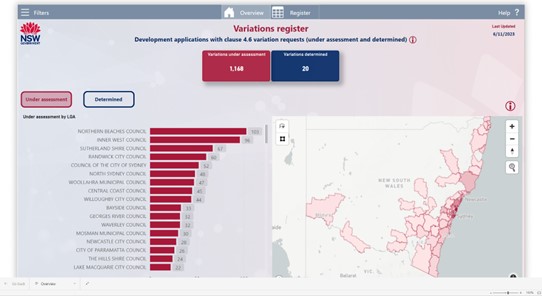Changes to Local Environment Plan clause 4.6 - Exceptions to Development Standards
13 November 2023
We would like to acknowledge the contribution of Mia Wilcox and Jordan Young.
Clause 4.6 'Exceptions to Development Standards' of the Standard Local Environmental Plan (LEP) has recently been simplified to provide more certainty about when and how development standards can be varied. Equivalent provisions in non-standard LEPs and State Environmental Planning Policies have also been enacted.
Along with these changes come new reporting requirements for Councils in the NSW Planning Portal.
The revisions aim to streamline the development approval process, increase transparency and consistency of application while maintaining a focus on environmental planning considerations.
The changes only apply to development applications lodged after 1 November 2023.
Key changes to clause 4.6
1. Retention of Existing Test: The test for determining applications under clause 4.6 remains substantively the same, but clause 4.6(3) now requires the applicant and the consent authority to demonstrate and consider the same matters when seeking and determining a variation to a development standard, being:
(a) that compliance with the development standard is unreasonable or unnecessary in the circumstances, and
(b) there are sufficient environmental planning grounds to justify the contravention of the development standard.
2. Removal of Public Interest Consideration: The specific requirement for the consent authority to assess whether the proposed variation is ‘in the public interest because it is consistent with the objectives of a particular standard or zone’ has been removed.
Consent authorities still have overarching obligations to ensure a proposed development is in the public interest, including under clause 2.3 of the Standard LEP, and s 4.15(1)(e) of the Environment Planning and Assessment Act 1979.
Whether a proposed development is consistent with the objectives of a development standard or zone may still be a relevant consideration for consent authorities in determining if compliance is ‘unreasonable or unnecessary’.
3. Requirement for the clause 4.6 request to be in writing: A request for an exception to a development standard must still be in writing, despite the phrase ‘written request’ being removed from s 4.6(3) of the Standard Instrument. This is because s 35B(2) of the Environmental Planning and Assessment Regulation 2021 (EP&A Regulation) provides that a development application (for a proposed development that will contravene a standard) “must be accompanied by a document” that sets out why the development standard is “unreasonable or unnecessary”, and that demonstrates “there are sufficient environmental planning grounds to justify the contravention of the development standard”.
A development application that will contravene more than one development standard requires separate written requests for each exception sought. A written request can be a stand-alone document or an appendix to a Statement of Environmental Effects.
4. Consolidation of Exclusions to clause 4.6: The nature and range of previous exclusions under clause 4.6(8) has been reduced, to address inconsistences and confusion in the application of the clause.
The NSW Department of Planning (the Department) has addressed these issues through a new s 9.1 Ministerial Direction on Exclusions and Guide to Exclusions from clause 4.6 of the Standard Instrument.
Increased transparency – new reporting requirements for Council
Enhanced reporting requirements for local councils through the NSW Planning Portal aim to achieve transparency, accountability and consistency.
A public register has been created to display details of all variation requests under assessment or lodged from 1 November 2023 on the NSW Planning Portal. This replaces the requirement for Councils to submit quarterly reports on variations to the Department.
The procedural requirement for variations to be approved by the Planning Secretary has also been removed.
Councils must update the public Planning Portal Register with:
- details of clause 4.6 development standard variation requests
- confirmation of which consent authority determined the DA, and
- the determining authority’s reasons for approving or refusing a development with a variation to a development standard (s 90A of the EP&A Regulation).
Consent authorities should find considering new variation requests under the amended clause 4.6 a more straightforward process, however Councils must be aware of their new reporting obligations on the NSW Planning Portal.



